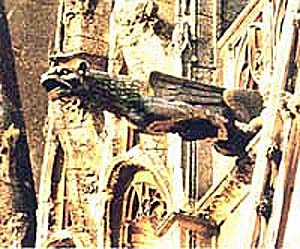 |
Symbolism
‘Be Sober and Watch’ - Vigilance in Symbols
Marian T. Horvat, Ph.D.
Walking through one of those huge and terrible malls the other day, I noticed a shop filled with gargoyles, those strange misshapen creatures with their “astonishing and deformed appearance,” as St. Bernard of Clairvaux described them. As a medievalist, my attention was caught. I entered the store and found a wide menagerie of creatures to place in your garden, set on your desk, adorn your fountain, and become your “little friend” or mascot.

This howling gargoyle is used as a gutter pipe
Saint-Etienne in Bourges, France |
My first reaction was shock to find that these monstrous creatures were being sold as a kind of new pet for the home without any reaction of indignation. A quite different mentality is nourishing the celebration of these figures, a mentality that reflects a modern spirit opposed to the Catholic spirit that gave birth to these bizarre beasts.
The first purpose of these creatures for the medieval man was didactic – to teach. Unlike modern man, medieval man did not create their monsters to be the stuffed-animal companions or like extra-terrestrial friends for their children. Instead, their express purpose was to frighten, to startle man amid his everyday life. These fantastic beasts were destined to be a clear and constant reminder that the devil and original sin exist. Alongside the beauty and splendor of the magnificent cathedral, the serpent lurks. They were born from a mentality that understand the need for constant vigilance. Just as the brilliant stained glass window was the Gospel in crystal, the gargoyle elucidated in stone those grave words of St. Peter: “Be sober and watch: because your adversary the devil, as a roaring lion, goeth about seeking whom he may devour.”
This is also how the medieval artists would depict the torments of Hell, a topic modern Catholic artists avoid for fear of frightening children – and adults. How horrible and barbarian, they shudder, contemplating images like the famous Trinity College Apocalypse scene, where an angel thrusts the beast into the Hell-Mouth while vultures feed on the corpses of kings, captains and even priests and bishops. Such pictures encouraged viewers to think about the final consequences of their behavior. Hell, like sin, is a reality. And figures like the gargoyles serve to remind man of the battle he must wage while he fights the good fight on this earth, which is a battleground, not a paradise or utopia.
Thus, the gargoyle reflects a mentality that understands God as the exemplary cause, the model of the universe. Hell itself was created by God, and can reflect His justice in punishing. So, in this sense, the ugly and horrible can be an expression of His just chastisement. It is interesting to consider that in the cathedral, in addition to the indisputable symbols of the goodness of God, we can observe the harmonic contrary of this as the expression of His justice. This expression of the contraries – justice and goodness – gives a broader understanding of Him.
Inferior symbols can help us to understand superior symbols, and in this hierarchy of symbols we have a mirror of God. This creates a state of mind where we are constantly making relationships between all things, in which the model of everything is the Creator. This sane way of thinking, when it exists as it existed in the Middle Ages and promises to exist in the days ahead, is reflected in the art, architecture, fashions, manners and customs of a people. Modern man, like medieval man, needs transcendent values that become concrete in symbols. And these symbols should serve to reflect God and to act as a constant reminder of the Creator.
|

Symbolism | Religious | Home | Books | CDs | Search | Contact Us | Donate

© 2002-
Tradition in Action, Inc. All Rights Reserved
|
 |
|
